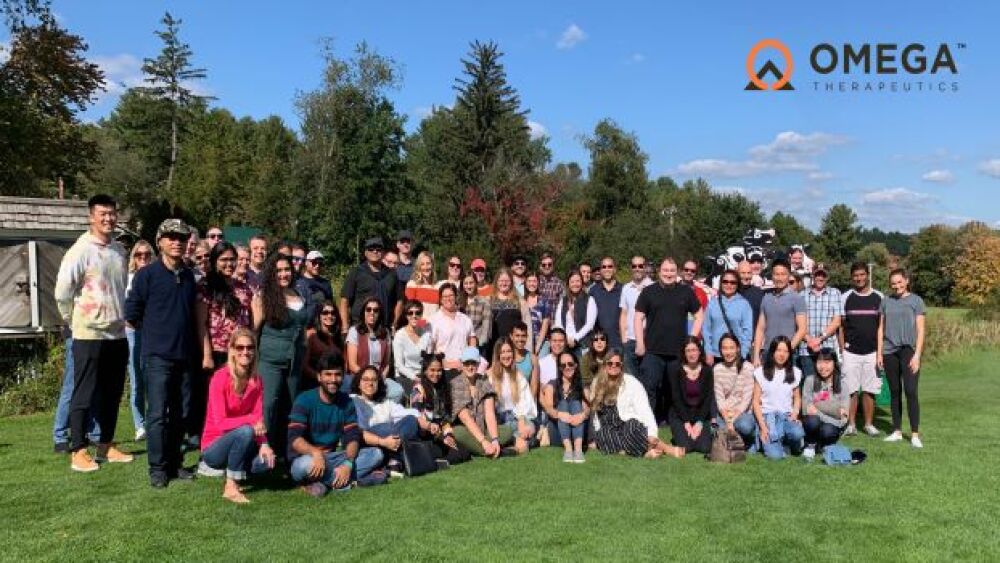Omega Therapeutics announced Thursday that the Investigational New Drug (IND) application for its hepatocellular carcinoma (HCC) candidate OTX-2002 has been granted by the FDA.
The Omega Therapeutics team, Courtesy Omega Therapeutics
Development-stage biotech company Omega Therapeutics announced Thursday that the Investigational New Drug (IND) application for its hepatocellular carcinoma (HCC) candidate, OTX-2002, has received clearance from the U.S. Food and Drug Administration.
This clearance will allow Omega to take OTX-2002 into a Phase I/II study, making it the first-ever epigenomic controller to enter clinical trials.
Omega first submitted an IND application for OTX-2002 last month. Two weeks later, the company added robust in vivo efficacy data to the candidate’s track record. The preclinical data showed that OTX-2002 treatment in non-human primates strongly suppressed MYC mRNA levels in the liver, mirroring its effect in HCC cell lines. Omega’s candidate also demonstrated good synergy with the current standard of care and with AKT inhibition.
“We are thrilled to obtain clearance to advance OTX-2002 into the clinic and are excited about the prospects of what this new class of medicines may mean for patients in need,” Mahesh Karande, president and chief executive officer of Omega Therapeutics, said in a statement. “This is an important milestone for our company, representing our first program to receive FDA clearance to enter the clinic and the first-ever clinical trial to evaluate an epigenomic controller.”
Delivered via lipid nanoparticles, OTX-2002 is an mRNA therapeutic agent that addresses HCC by pre-transcriptionally dampening c-Myc expression epigenetically. That is, rather than directly modifying the native c-Myc gene sequence, OTX-2002 acts on other molecules in the vicinity of the DNA that can influence which genes are expressed and to what degree.
“This new class of programmable mRNA therapeutics leverages our groundbreaking science and has broad potential applicability in many therapeutic areas,” Karande added.
Indeed, OTX-2002 represents Omega’s pioneering approach to therapeutics. At the core of the company is its proprietary OMEGA Epigenomic Programming platform, which uses a systematic, rational and holistic drug design protocol, allowing Omega to find promising compounds that can address the genetic root of diseases without leaving lasting changes on the genes.
Using in-house machine learning tools, Omega has also cultivated a list of nearly 15,000 discrete structural units in the chromosome that it believes to be the “universal operating system” of gene expression. These units, which the company calls EpiZips (as in the epigenomic zip code), now act as the drug targets for the OMEGA platform.
Aside from the HCC candidate, Omega’s pipeline includes other modular mRNA medicines for small cell and non-small cell lung cancer. The company also has candidates for alopecia, liver regeneration and COVID-19, all in preclinical development.
Though a first-in-class agent, OTX-2002’s IND nod puts it among the ranks of other HCC hopefuls. Last month, Teclison’s tirapazamine yielded promising Phase I peer-reviewed results in early- and intermediate-stage disease when used in combination with trans-arterial chemoembolization. A Phase II study for this approach is currently ongoing.
A week later, Codiak BioSciences’ exoASO-STAT6 started its Phase I trial to assess its safety, tolerability and preliminary antitumor activity. The candidate is an engineered exosome and also takes a precision medicine approach to HCC. Also entering the clinic is Shanghai’s JW Therapeutics, which last week announced that it was initiating a Phase I study of its T-cell therapy candidate JWATM204.
Featured Jobs on BioSpace






